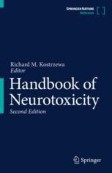Search
Search Results
-
Botulinum Neurotoxin History
Botulinum toxin is an incredibly potent neurotoxin produced by the bacteria Clostridium botulinum. There are eight known serotypes (A, B, C1, C2, D,...
-
Botulinum Toxin Therapy-Future Perspectives
New potential applications for botulinum neurotoxin (BoNT) therapy are constantly emerging through the expanding literature in the field of clinical...
-
Botulinum neurotoxin serotype A inhibited ocular angiogenesis through modulating glial activation via SOCS3
BackgroundPathological angiogenesis causes significant vision loss in neovascular age-related macular degeneration and other retinopathies with...

-
Botulinum Neurotoxin History
Botulinum toxin is an incredibly potent neurotoxin produced by the bacteria Clostridium botulinum. There are eight known serotypes (A, B, C1, C2, D,...
-
Clostridia: Botulinum-Neurotoxin (BoNT)-Producing Clostridia, Clostridium perfringens, and Clostridioides difficile
Clostridium spp., anaerobic spore-forming bacteria, are not commonly counted among the classical zoonotic agents. They are regularly found in the...
-
Clostridia: Botulinum-Neurotoxin (BoNT)-Producing Clostridia, Clostridium perfringens, and Clostridioides difficile
Clostridium spp., anaerobic spore-forming bacteria, are not commonly counted among the classical zoonotic agents. They are regularly found in the...
-
Dissociation mechanics and stability of type A botulinum neurotoxin complex by means of biophysical evaluation
PurposeBiophysical characterisation of type A botulinum neurotoxin (BoNT/A) could be challenging since it exists in association with neurotoxin...

-
The History of Botulinum Neurotoxin Development
This chapter provides information on the history and development of botulinum neurotoxins as a therapeutic tool in clinical medicine. It discusses...
-
Botulinum Toxin Therapy in Veterinary Medicine
Emerging literature supports that local injection of botulinum toxins can help local pain in animals. In dogs, botulinum toxin injections have been...
-
Botulinum neurotoxin A ameliorates depressive-like behavior in a reserpine-induced Parkinson’s disease mouse model via suppressing hippocampal microglial engulfment and neuroinflammation
Depression is one of the common non-motor symptoms of Parkinson’s disease (PD). In the clinic, botulinum neurotoxin A (BoNT/A) has been used to treat...

-
Botulinum Toxin Treatment in Children
Over the past 35 years, botulinum toxin therapy in adults has been established as a major mode of treatment for a variety of medical conditions....
-

-
Botulinum Toxin Treatment in Dentistry
Over the past 20 years, researchers and clinicians have found different potential indications for the use of botulinum toxin therapy in dentistry....
-
Recombinant L-HN Fusion Antigen Derived from the L and HN Domains of Botulinum Neurotoxin B Stimulates a Protective Antibody Response Against Active Neurotoxin
Botulinum neurotoxin (BoNT) is a neurotoxin produced by Clostridium botulinum in an anaerobic environment. BoNT is the most toxic protein among...

-
Botulinum Toxin Treatment in Multiple Sclerosis
According to the latest data from the National Multiple Sclerosis Society (2019) nearly one million people live in US with this disease annually. The...
-
Botulinum Toxin Treatment in Aesthetic Medicine
This chapter describes the spectrum of botulinum toxin applications in the field of aesthetic medicine including treatment of wrinkles at different...
-
Intratracheal inoculation of AHc vaccine induces protection against aerosolized botulinum neurotoxin A challenge in mice
Botulinum neurotoxin (BoNT), produced by Clostridium botulinum , is generally known to be the most poisonous of all biological toxins. In this study,...

-

-
Botulinum Neurotoxin: Could it Change the Way Sleep Looks Like after Cosmetic Treatment? A Focus on the Polysomnographic Traits
PurposeSleep is a crucial component of life, characterized by global behavioral and neurochemical inhibition of brain activity. The gold-standard...
-
Toxicology and pharmacology of botulinum and tetanus neurotoxins: an update
Tetanus and botulinum neurotoxins cause the neuroparalytic syndromes of tetanus and botulism, respectively, by delivering inside different types of...

